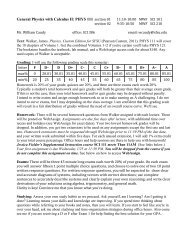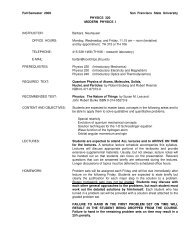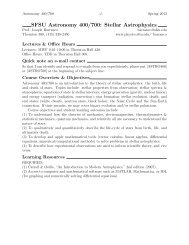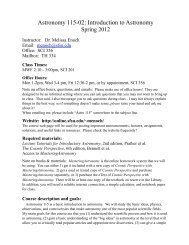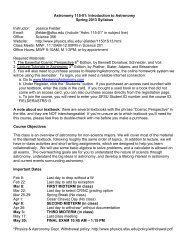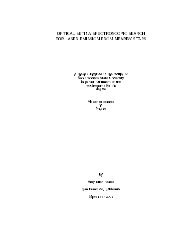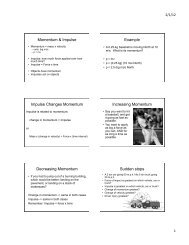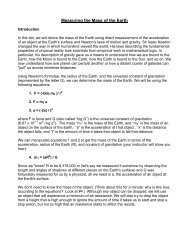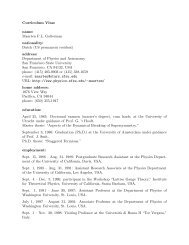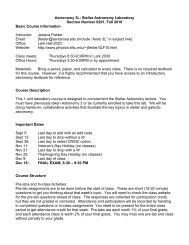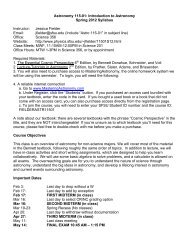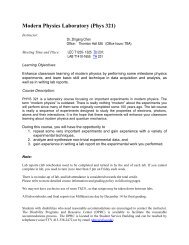Solutions for Chapter 2 Activity 6 Homework - SFSU Physics ...
Solutions for Chapter 2 Activity 6 Homework - SFSU Physics ...
Solutions for Chapter 2 Activity 6 Homework - SFSU Physics ...
You also want an ePaper? Increase the reach of your titles
YUMPU automatically turns print PDFs into web optimized ePapers that Google loves.
CHAPTER 2<br />
Developing Ideas<br />
ACTIVITY 6 HW: Changing Direction<br />
Name:________________________________ Date:_______________ Group: ______<br />
Purpose<br />
You have seen that when an object is already moving, a <strong>for</strong>ce acting on it in<br />
the same direction as its motion will make it speed up, while a <strong>for</strong>ce in the<br />
opposite direction to the motion will make it slow down. But what if the <strong>for</strong>ce<br />
is applied in a direction that is from the side with respect to the motion? What<br />
effect will such a <strong>for</strong>ce have?<br />
For instance, what would happen to the motion of a<br />
spacecraft if it fired a small engine on its side while it<br />
was moving <strong>for</strong>ward?<br />
What effect does a sideways <strong>for</strong>ce have<br />
on an object that is already moving?<br />
Collecting and Interpreting Evidence<br />
Experiment #1: What happens if a moving object is tapped on the side?<br />
You will need:<br />
Soccer ball (or similar)<br />
Stick (or some other object than can be used to tap the ball firmly)<br />
STEP 1: Start the ball rolling across the floor by giving it a sharp tap with the<br />
stick. While it is moving, give it a second sharp tap, but this time at right<br />
angles to its direction of motion. (See picture below.) Pay careful attention to<br />
both the speed and direction of the ball after this second tap.<br />
© 2007 PET 2-109
<strong>Chapter</strong> 2<br />
Note: It is very important to make sure that the strength of the<br />
sideways tap you apply to the ball is of about the same strength<br />
as the tap you used to start the ball moving in the first place.<br />
On the diagram above, sketch the path of the ball, after the sideways tap.<br />
After the sideways tap, is the ball’s motion in the same direction as<br />
be<strong>for</strong>e the tap, in the direction of the sideways tap itself, or somewhere<br />
in between the two? (If you are not sure, you may wish to repeat the<br />
experiment, making sure the strength of both the initial and sideways<br />
taps is close to the same.)<br />
It is somewhere in between the two.<br />
Why do you think the direction of the ball’s motion, after the sideways<br />
tap, is different from its original direction?<br />
The sideways tap made it change direction.<br />
Why do you think the direction of the ball’s motion, after the sideways<br />
tap, is different from the direction of the sideways tap itself?<br />
The ball was already moving to the right and it keeps on moving that way. The tap<br />
made it move upward as well, so after the tap it is moving both to the right and<br />
upward, which is more of a diagonal.<br />
2-110
<strong>Activity</strong> 6 <strong>Homework</strong><br />
In this experiment the direction of the ball’s motion changed as a result of the<br />
<strong>for</strong>ce exerted on the ball by the stick during the interaction between them.<br />
Do you think a <strong>for</strong>ce is always needed to change the direction of motion<br />
of a moving object, or can the direction change on its own? Why, or why<br />
not? Give two other examples to illustrate your thinking.<br />
Yes, I think a <strong>for</strong>ce is always needed to change the direction of a moving object.<br />
All changes in motion (speed or direction) need an outside cause. Other examples<br />
would be a soccer player kicking a moving soccer ball so it changes direction, or a<br />
hockey player hitting a sliding puck with his stick so as to redirect it.<br />
Experiment #2: Simulator Exploration. What happens if a continuous<br />
sideways <strong>for</strong>ce acts on a moving object?<br />
You will need:<br />
Access to the I&M computer simulator<br />
STEP 1: As be<strong>for</strong>e, imagine that there is a soccer ball (or a ball of similar size<br />
and mass) rolling across the floor in front of you. At some point you give it a<br />
quick sideways tap that changes its direction, as shown below. A short time<br />
later you give it another sideways tap (relative to its new direction of motion).<br />
Suppose you were to keep giving<br />
such sideways taps (always<br />
relative to the direction of motion<br />
at that time) at regular intervals,<br />
and always from the same side of<br />
the ball. What would the path of<br />
the ball look like in this case?<br />
Sketch your idea on the<br />
picture to the right, showing<br />
the path of the ball and its<br />
position when the taps are<br />
applied.<br />
Explain your reasoning.<br />
2-111
<strong>Chapter</strong> 2<br />
Each tap will change the direction of the ball, making it turn in the same direction<br />
each time.<br />
STEP 2: You can compare your ideas with those of scientists<br />
by using the I&M Simulator. Open the first set-up file <strong>for</strong> this<br />
homework assignment. You will see an object that is already<br />
moving toward the top of the screen (or will be when you run<br />
the simulation).<br />
Note: as be<strong>for</strong>e, the red half-arrow is a speed-arrow <strong>for</strong> the<br />
ball, representing the speed and direction of its motion. Any<br />
<strong>for</strong>ces acting on the object will be represented by black<br />
arrows, as in the other simulators.<br />
Run the simulation and, while the object is moving, apply some sideways<br />
taps at regular intervals (using the spacebar on the keyboard) to try and<br />
make the object follow the octagonal path shown on the set-up.<br />
Sketch the path, and indicate the<br />
points at which you had to give the object a<br />
tap to get it to follow that path.<br />
Why do you think you had to apply a tap at those particular points?<br />
To make it change direction at that point.<br />
In between each pair of sideways taps, what is the path of the object<br />
like? Why do you think this is?<br />
In between taps the path is straight, because there is no <strong>for</strong>ce to change the<br />
direction<br />
STEP 3: In the simulator, the taps are represented with black <strong>for</strong>ce arrows.<br />
Run the simulator again, and watch carefully the direction in which each tap<br />
is aimed.<br />
Is each individual tap aimed in the object’s direction of motion be<strong>for</strong>e<br />
the tap, its new direction after the tap, or in a direction between the two?<br />
The taps are aimed in a direction between the two.<br />
2-112
<strong>Activity</strong> 6 <strong>Homework</strong><br />
Are all the taps aimed in the same direction, or is there some other<br />
simple way to describe how they are directed? (For example, is there<br />
some common point they are all aimed toward?)<br />
They are all aimed toward the center of the octagon.<br />
Now, suppose that, instead of quick taps, you were able to apply a<br />
continuous sideways <strong>for</strong>ce to the object as it moves.<br />
What shape do you think its path would be then? Explain your<br />
reasoning.<br />
The path would be a circle shape because the continuous <strong>for</strong>ce would make the<br />
direction change continuously.<br />
STEP 4: To check your idea, open the second simulator set-up file <strong>for</strong> this<br />
homework assignment. This set-up shows an object that is initially moving<br />
diagonally up and to the right. (Note the direction of the speed arrow.)<br />
However, when the simulation is run, a continuous <strong>for</strong>ce will be applied that<br />
is always directed sideways with respect to the direction of motion.<br />
Run the simulation, and sketch the path of the object below. Choose four<br />
points on the path and draw the object at those points, together with its<br />
speed arrow and an arrow representing the <strong>for</strong>ce acting on it at that<br />
point.<br />
(Alternatively, if you are completing this homework assignment<br />
electronically, you can use the ‘snapshot’ tool in the simulator and<br />
then paste the pictures into this document.)<br />
2-113
<strong>Chapter</strong> 2<br />
At any particular moment in time how would you describe the direction<br />
of motion of the object? Is it headed outward (away from the center of<br />
the circle), inward (toward the center of the circle), or at a tangent to the<br />
circle?<br />
The red speed arrows show the direction of motion. They always seem to be aimed<br />
at a tangent to the circle.<br />
What is the relationship between the direction of motion of the object<br />
and the direction of the <strong>for</strong>ce acting on it? Do they always point in the<br />
same direction, opposite directions, or are they related in some other<br />
way (you describe it)?<br />
The black <strong>for</strong>ce arrows always point toward the center of the circle, whereas the<br />
speed arrows are at a tangent to the circle. They always seem to be at right<br />
angles to each other. This makes sense as it is sideways <strong>for</strong>ces that change the<br />
direction.<br />
Is there a common point toward which the <strong>for</strong>ce always points? If so,<br />
what is it?<br />
Yes, the <strong>for</strong>ce always points toward the center of the circle.<br />
What do you think would happen if, while the object was moving in its<br />
circular path, the ‘sideways’ <strong>for</strong>ce were to disappear? How do you think<br />
the motion of the object would change? Explain your reasoning.<br />
With no more <strong>for</strong>ce to change the direction, the object would then move in a<br />
straight line.<br />
2-114
<strong>Activity</strong> 6 <strong>Homework</strong><br />
You can remove the continuous sideways <strong>for</strong>ce by tapping on the spacebar in<br />
this set-up. Start the simulation running again, let it run <strong>for</strong> a few seconds,<br />
and then remove the <strong>for</strong>ce.<br />
Sketch the path of the object, both be<strong>for</strong>e and after, you remove the<br />
sideways <strong>for</strong>ce. Again, choose some points on the path (both be<strong>for</strong>e and<br />
after you removed the <strong>for</strong>ce) and draw the object at those points,<br />
including its speed arrow and <strong>for</strong>ce arrow (if relevant).<br />
Did the behavior of the object when the <strong>for</strong>ce was removed agree with<br />
your prediction above? If not, try to explain it.<br />
Yes it agrees.<br />
2-115
<strong>Chapter</strong> 2<br />
Two students in a previous class were discussing what happens to an object<br />
moving in a circle, when the <strong>for</strong>ce making it do so is removed.<br />
I think that, since there is no longer a<br />
<strong>for</strong>ce to make it change direction, the<br />
object will move in a straight line, in<br />
the direction its was headed at the<br />
moment the <strong>for</strong>ce was removed.<br />
I’m not so sure. I do think it will move<br />
in a straight line, but the direction<br />
will be the same as the direction of<br />
the last <strong>for</strong>ce that acted on it.<br />
Samantha<br />
Who do you agree with (or neither), and why?<br />
Kristen<br />
We agree with Samantha. The last <strong>for</strong>ce that acted on the object in the simulator<br />
pointed toward the center of the circle, but when the <strong>for</strong>ce was removed that’s<br />
not the direction the object moved. Instead it moved at a tangent to the circle,<br />
which is where it was headed at that moment anyway.<br />
Summarizing Questions<br />
Write your own answers to these questions. Leave space to add any<br />
different ideas that may emerge when the whole class discusses their<br />
thinking.<br />
S1: What effect does a sideways <strong>for</strong>ce have on the motion of an object? Does<br />
it seem to change the speed, as <strong>for</strong>ward and backward <strong>for</strong>ces do, or does<br />
it change some other aspect of the motion (or both)?<br />
Definitely changes the direction. Hard to tell if the speed changes significantly.<br />
S2: If a continuous sideways <strong>for</strong>ce acts on an object while it is moving, and<br />
always points toward one place, what will the object’s path be like?<br />
2-116
<strong>Activity</strong> 6 <strong>Homework</strong><br />
It will move in a circle because the continuous <strong>for</strong>ce will change the direction<br />
continuously<br />
S3: If no sideways <strong>for</strong>ces act on a moving object, what will its path be like?<br />
Explain your reasoning.<br />
It will move in a straight line because there are no <strong>for</strong>ces to change the direction.<br />
S4: Imagine tying a stuffed toy to a string<br />
and swinging it around in a horizontal<br />
circle above your head at a constant<br />
speed. (A top view is shown here. The<br />
curved arrow simply indicated the<br />
direction of rotation.) Does a sideways<br />
<strong>for</strong>ce act on the toy? How do you know?<br />
Yes, a ‘sideways’ <strong>for</strong>ce must act on the toy to<br />
keep changing its direction so that it moves in<br />
a circle.<br />
What other object do you think is exerting this <strong>for</strong>ce on the toy?<br />
The string is exerting the sideways <strong>for</strong>ce.<br />
On the picture above, draw a speed arrow and an arrow representing<br />
the <strong>for</strong>ce acting on the toy.<br />
S5: Now, suppose, after the toy has moved<br />
a bit further round the circle, the string<br />
were to break when the toy was in the<br />
position shown in this diagram. Draw a<br />
line on the diagram to show what the<br />
path of the toy would be after that<br />
happened. Explain your reasoning<br />
below.<br />
The <strong>for</strong>ce that is changing its direction has gone, so it moves in a straight line in<br />
the direction it was headed when the string broke.<br />
2-117
<strong>Chapter</strong> 2<br />
The nature of sideways <strong>for</strong>ces<br />
It is important to realize that the <strong>for</strong>ces that cause objects to change direction<br />
(moving in a circular path is just a continuous change in direction) are the<br />
same as the <strong>for</strong>ces that cause objects to speed up or slow down. For example,<br />
if your second tap in Experiment #1 had been in the same direction as the<br />
motion of the ball, then the ball would have sped up, rather than changed<br />
direction. If the tap had been in the opposite direction to the motion, it would<br />
have slowed down. The difference in effect was due to the direction in which<br />
the <strong>for</strong>ce was applied, relative to the motion, rather than anything different<br />
about the <strong>for</strong>ce itself.<br />
This is true of all <strong>for</strong>ces. For example, a hit from a hockey stick could be used<br />
to make a puck speed up, slow down and stop, or change direction,<br />
depending on how it is applied. Another example would be the <strong>for</strong>ce of<br />
gravity (which you will study in the next <strong>Chapter</strong>), which makes objects fall<br />
to the ground, but is also responsible <strong>for</strong> keeping the Moon in its (nearly)<br />
circular orbit around the Earth.<br />
In the summarizing questions you considered a <strong>for</strong>ce exerted by a string<br />
(which scientists call a ‘tension’ <strong>for</strong>ce) that made a stuffed toy<br />
continuously change direction, and so move in a circular path. Describe,<br />
and sketch, two other situations, one in which the tension <strong>for</strong>ce in a<br />
string is being used to make an object speed up, the other in which the<br />
same <strong>for</strong>ce is being used to slow an object down.<br />
You could pull on a string attached to a sled on an icy surface. That would make it<br />
start to move and speed up.<br />
Pulling<br />
<strong>for</strong>ce<br />
Once the sled is moving, you could also pull backwards on it with the string to make<br />
it slow and stop.<br />
Pulling<br />
<strong>for</strong>ce<br />
2-118



